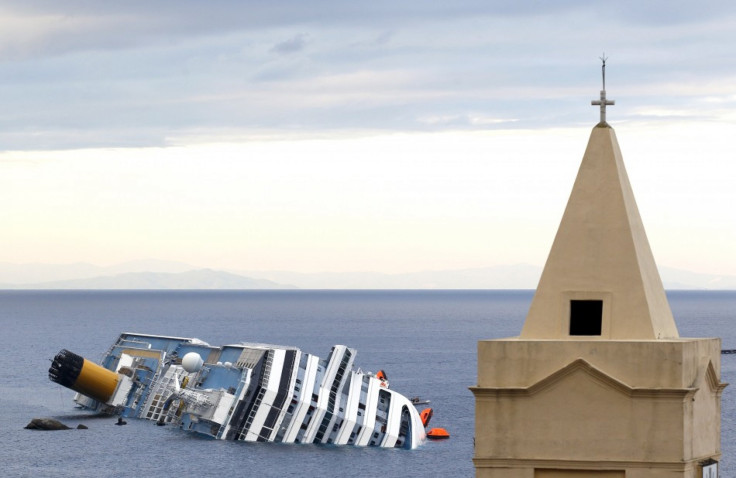Cruise Ship Sinking: Carnival’s Disaster Upsets the Whole Industry

The images of the Costa Concordia lying belly up in the seas off of Italy's Giglio Island are disastrous for Carnival Cruise Lines, which owns the ship. But unknown is how bad the crash will be for the rest of the pleasure cruise industry, and the stranded boat may become an unwelcome metaphor for how companies in the sector will perform in the coming months.
This was the worst [accident] we've seen in the cruise industry, Mark Murphy, the CEO of Travalliance told the IBTimes. It's not going to die down anytime soon. As long as there are images of the ship lying in the water, this thing is going to be challenge for the industry for a while.
At least six people died when the captain of the Costa Concordia brought the ship too close of the shores of the Tuscan island on Friday night, running aground and causing the ship to list severely. In just three minutes the boat had been flooded with massive amounts of water. Most of the 4,200 passengers were evacuated safely but sixteen people are still missing.
With the search and rescue efforts halted as of Monday afternoon, Carnival has begun its damage assessment to determine what the loss means for the company. The decommissioning of the ship will alone cost the company about $95 million this year, even if the boat can eventually be salvaged, which at this point is unclear.
The Concordia was built in 2006 for a cost of $570 million, and although it's insured for $513 million, Carnival faces a $30 million deductible for damage and a $10 million deductible on its injury liability plan, according to Property Casualty 360.
Less certain is the impact the accident will have on would be cruise-goers. About 20 percent people in U.S. have taken cruises, Murphy noted, and convincing the 80 percent who haven't is the industry's chief errand.
The 80 percent is the challenge, Murphy said, and anyone who had a hesitation in the past won't want to board a boat after a tragedy like the one in Italy on Friday.
An incident on one boat is therefore a challenge for each and every cruise ship company. While Carnival will take the brunt of the financial ramifications, its biggest competitors are already taking a hit in the markets.
On Monday, shares in Carnival PLC dropped about 17 percent on the London exchange, totaling a loss of about $1 billion. (In U.S. trading, Carnival shares fell about 2.5 percent). Things were better for Carnival's main competitor, but not much: shares of Royal Caribbean declined by about 2.6 percent on the NYSE and 7.5 percent for its shares listed in Oslo, according to Yahoo.
Royal Caribbean did not return calls for comment.
Rippling effects
With the ship now lying horizontal in the seas off of Giglio, Carnival is bracing to see if bad PR will turn its long-term profits belly-up. But more significant is the impact that the accident will have on the relatively new pleasure cruising industry as a whole.
Compared to other forms of travel, cruising is actually one of the safest ways to vacation, and each disaster leads to new safety measures. A number of fires in the 1990s gave way to designated and self-contained fire zones on all ships, as well as sprinklers, non-combustible furniture, an increased number of smoke detectors and fire doors. When 42 people were injured when huge waves hit a Pacific Sun cruise in 2010, the company began securing tables and other fixtures to the deck.
Still, there seems to be an incident on a ship every few years, and that has put a stigma on the industry as a whole. One passenger was killed during a fire on Princess Cruises' Star Princess in 2006, outbreaks of norovirus and other gastrointestinal diseases are not uncommon, and last January a British cruise ship in the Indian Ocean was boarded by Somali pirates.
Rough Seas
Like most travel industries, cruising is a complex business. While events like the Costa Concordia disaster certainly hurt, there are other factors that are steering profits in all directions.
Any negative deters some people, but the industry has been growing year-over-year for the past decade. It's about doubled, said Murphy, adding that new boats and new features on those boats have changed the business by making the ships destinations unto themselves.
In the U.S., it's a market because of the Baby Boomer generation, and it's a market that should continue to grow. These people want to travel and they control about 50 percent of discretionary spending in the US, he said.
Yet after ten years of growth, the financial crisis that started in 2008 has caught up to the industry, especially for European carriers. Rising fuel prices, airline costs and the diminished number of seats flying to Europe have all conspired to limit the number of boats that companies can build and launch.
Ships are what drive the industry, Murphy noted, and because only about seven new ships will sail this year, yields are expected to drop.
But regardless of what happens to the industry as a result of the global economy, the sinking of the Costa Concordia is going to have an undeniable effect on the cruising business.
© Copyright IBTimes 2024. All rights reserved.











